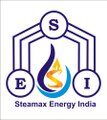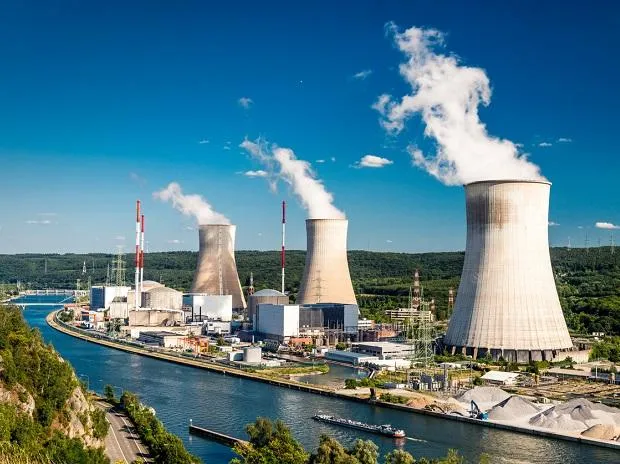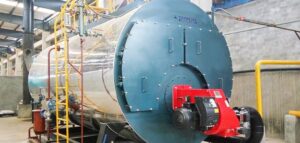Thermal power plants are one of the most widely used methods of electricity generation worldwide. In these plants, the process of converting thermal energy (usually from burning coal, oil, or gas) into electrical energy relies heavily on steam boilers. Boiler in a thermal power plant accumulates the steam and builds up a pressure to expend it in a turbine and convert thermal energy to mechanical energy. The generator which is connected to the turbine converts the mechanical energy into electric energy. This blog will explore the essential function of steam boilers in thermal power plants and highlight Steamax Energy India, a leading provider of innovative steam boiler solutions.
Also Read Us: Steam Boiler Diagram
What is a Steam Boiler?
A steam boiler is a device used to create steam by applying heat energy to water. The heat is usually provided by burning fuels such as coal, oil, or natural gas. The produced steam, typically at high temperatures and pressures, is then used to drive turbines in thermal power plants. This conversion of thermal energy into mechanical energy is the primary step in generating electricity. Although the definitions are somewhat flexible, it can be said that older steam generators were commonly termed steam boiler and worked at low to medium pressure (1–300 psi or 6.895–2,068.427 kPa) but, at pressures above this, it is more usual to speak of a steam generator.
Uses of Steam Boilers in Thermal Power Plants
1. Heat Generation
The fuel (such as coal, oil, or gas) is burned in a furnace within the boiler, generating high amounts of heat. This heat is transferred to water inside the boiler, raising its temperature to the point where it turns into steam.
2. Steam Production
Generally, the liquids are stored in the boiler for generating steam by burning the fuels or applying the heat energy at different conditions of pressure based on the size of the vessel as well as specifications. Finally, the steam in the boiler supplies using a pipe and flows into various industries like plants. Once the water is heated to its boiling point, it transforms into high-pressure steam. The steam is then directed towards the turbine, where it expands, causing the turbine blades to rotate. This rotational energy is converted into mechanical energy that ultimately powers the generator to produce electricity.
3. Pressure and Temperature Control
The pressure and temperature of the steam need to be carefully controlled to ensure optimal efficiency. The steam must have enough pressure to drive the turbines efficiently, but not so much that it causes damage to the system. Modern steam boilers are equipped with sophisticated systems that monitor and control these parameters.
4. Efficient Heat Exchange
Efficient heat transfer is critical for minimizing energy waste. Steam boilers are designed with heat exchangers that help capture and utilize as much heat as possible, ensuring that the steam produced is of the required quality and quantity for turbine operation.
5. System Efficiency
The efficiency of a thermal power plant largely depends on the steam boiler’s performance. The more efficient the boiler, the better the overall plant performance. This involves minimizing fuel consumption, reducing emissions, and maximizing energy output.
Steam Boiler Working Principle
The main working principle of a steam boiler is easy. This boiler is one type of closed device in the shape of a cylindrical. The capacity of the boiler to have steam, as well as water is sufficient.
Generally, the liquids are stored in the boiler for generating steam by burning the fuels or applying the heat energy at different conditions of pressure based on the size of the vessel as well as specifications. Finally, the steam in the boiler supplies using a pipe and flows into various industries like plants.
The main components of this boiler mainly include a shell, furnace, grate, mountings, water space, accessories, refectory, level of water, scale, foaming, lagging, and blowing off
The working process of a steam boiler starts with the combustion of fuel (like coal, oil, or natural gas) in the furnace or combustion chamber. This generates heat energy, which is transferred to the water inside the boiler.
Why Steamax Energy India?
Steamax Energy India is a trusted name in the steam boiler industry, offering high-quality steam boiler solutions for thermal power plants. Their products are designed to meet the highest standards of efficiency, safety, and reliability, ensuring optimal performance in energy generation. Here’s why Steamax Energy India is a preferred choice for many thermal power plants:
1. Innovative Technology
Steamax Energy India is known for using advanced technology in the design and manufacture of steam boilers. They incorporate the latest features to improve efficiency, reduce fuel consumption, and enhance overall performance, ensuring that thermal power plants can operate at peak efficiency.
2. Custom Solutions
Steamax offers customized steam boiler solutions tailored to meet the specific needs of different industries. Whether it’s a large-scale power plant or a smaller, specialized facility, they provide designs that optimize energy production and minimize downtime.
3. Energy Efficiency
One of the key aspects of any steam boiler is energy efficiency. Steamax Energy India focuses on producing boilers that maximize heat recovery and minimize energy losses. Their systems are designed to provide the best performance while reducing fuel costs and carbon emissions.
4. Quality and Durability
With a focus on durability and long-lasting performance, Steamax Energy India manufactures boilers that are built to withstand the rigors of continuous operation in demanding environments. Their products are known for their robustness and minimal maintenance requirements, helping thermal power plants to reduce operational costs.
5. Expert Support and Service
Steamax Energy India also offers comprehensive after-sales support, including installation, maintenance, and troubleshooting services. Their team of experts ensures that steam boilers are always running efficiently, minimizing the risk of downtime and maximizing energy production.
Conclusion
Steam boilers are at the heart of thermal power plants, enabling the conversion of heat energy into mechanical energy for electricity generation. Their role in providing the high-pressure steam needed to drive turbines is crucial for the efficiency and effectiveness of the plant. The water turns into high-pressure steam, which is used to perform mechanical work, such as driving turbines or providing heat to various industrial processes. As the demand for reliable and efficient energy grows, companies like Steamax Energy are leading the way by providing state-of-the-art steam boiler solutions that enhance the performance of thermal power plants.


